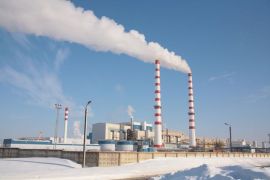Energy, Estonia, Investments, Legislation
International Internet Magazine. Baltic States news & analytics
Friday, 26.04.2024, 06:16
"Eyewitness": Eesti Energia's major investment was based on inadequate information
 Print version
Print version |
|---|
Currently, around a thousand workers are building the world's biggest oil shale-fuelled boiler near Narva where the first of the two new production blocs of Eesti Energia's Narva Power Plants would be erected, writes LETA.
But as documents that had been declared confidential earlier indicate, the investment is based on legally questionable basis and will most likely work with very low capacity most of the time.
State Audit Office chief auditor Tarmo Olgo said that building the Narva blocs, the first stage of which costs around 600 million euros and the next maybe 400 million euros is not necessary as it won't contribute anything to the market. "It won't make bourse price cheaper, wont yield Estonia higher electric energy security. It is not economically feasible, it certainly needs subsidising; the electricity produced there will reach free market when demand is very high, supply a bit smaller or when the price of electricity at the bourse is very high. Most of the time it may be at standstill or is just kept working as a reserve," said Olgo.
The TV show said that politicians were warned that this might be the case from the start, as documents that had been confidential earlier but now are public, indicate.
The show says that when the procurement deadline for the new Narva blocks came on July 1, 2010, the state was in great hurry since EU environmental requirements threatened to close a half of the old Narva power stations by the start of 2016.
Global company Alstom with a 989 million euro price bid was declared the winner among two submitted bids, but actually the bid was not in line with the requirements. The other bid, by SNC Lavalin, was 875 million euros but was rejected as it wasn’t in line with requirements. Alstom's bid was not rejected though because it was thought that in the next procurement, the price offered could have been even higher. Finally in December 2010 Eesti Energia council decided to conclude the agreement. On January 7, 2011 however, the European Commission published a laxer directive of industrial waste that allowed the old Narva power stations to operate till 2023. Still, Eesti Energia management signed the contract with Alstom a week later.
Since it was clear that it wasn't possible to produce electricity from oil shale at market conditions, the state had to pay subsidies. Initially the talk was about 1.5 billion EEK over 20 years. The European Commission however didn't want to even hear of such a subsidy. The process was suspended till elections in March 2011.
After the new government stepped in office, economy and communications minister Juhan Parts raised the topic of the contract at a closed government session on May 5. Parts did not mention that there was another bid at the procurement that was by 100 million euros cheaper, but was disqualified. He didn’t mention that Brussels had granted an extension to the old stations and that a fresh study indicated that Eesti Energia needs no new capacity at least till 2020.
The State Audit office sent a letter pointing out these issues to the government but the government approved of the Alstom contract on May 5, 2011 anyway.
Economy Minister Juhan Parts did not find time to talk to the show.








 «The Baltic Course» Is Sold and Stays in Business!
«The Baltic Course» Is Sold and Stays in Business!

